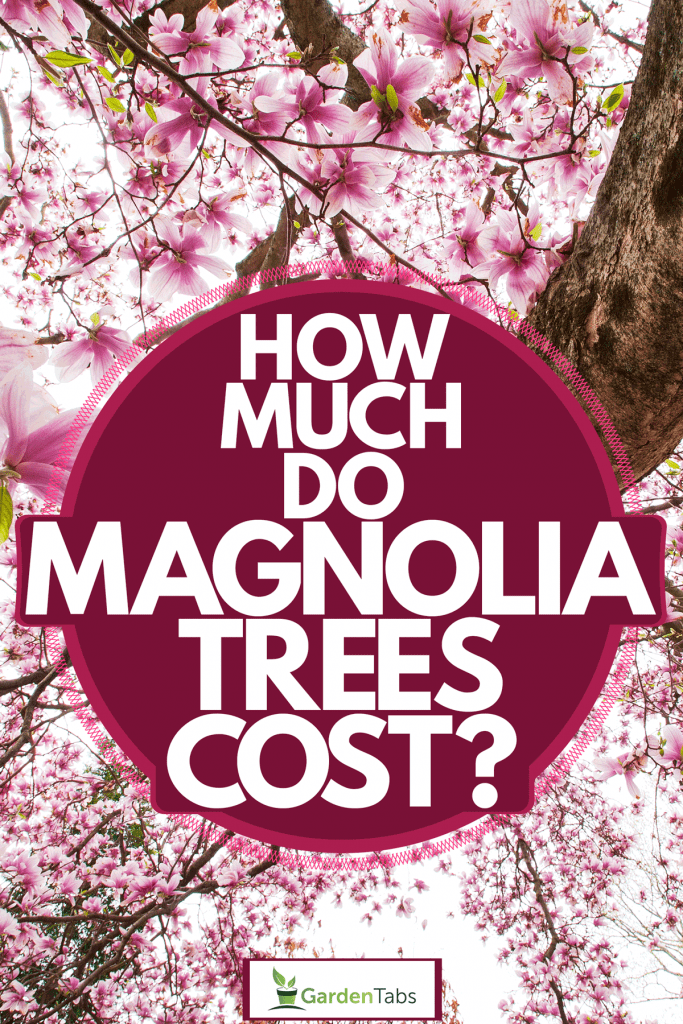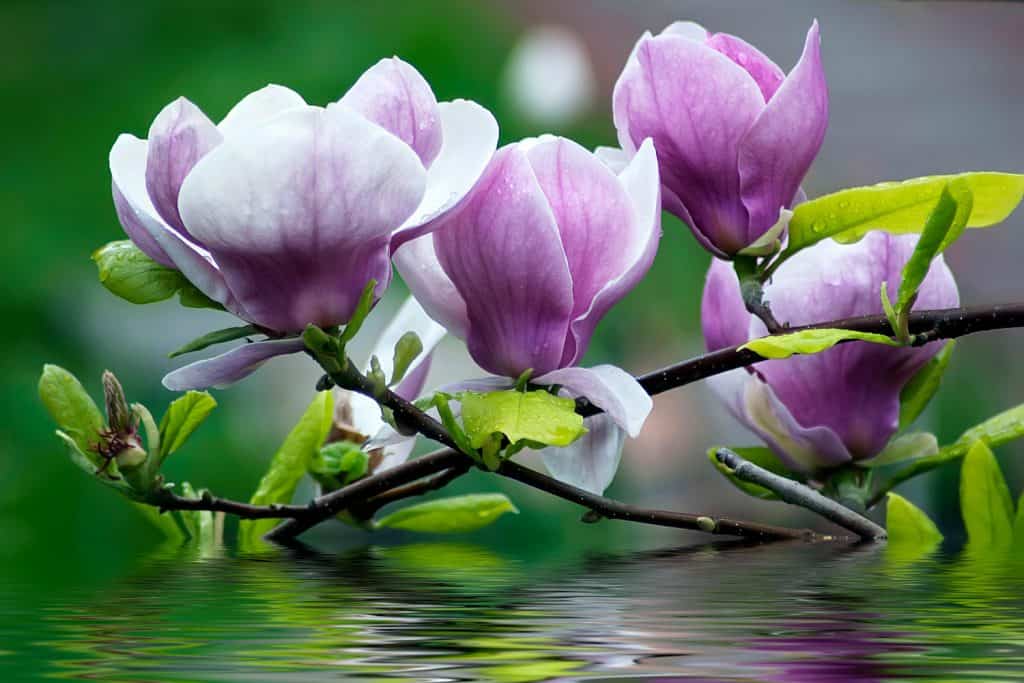Magnolia trees can provide beautiful landscaping in both shrub or tree form. These popular trees showcase fragrant flowers which can range in color from reddish-pink and white to purple or yellow, depending on the variety. If you are considering purchasing a Magnolia tree for the first time, you may be wondering how much they cost. Well, we've looked into this for you and have the answer.
Magnolia trees are one of the most popular plants that you can purchase for your home. In addition to being mesmerizing to look at, they are also generally inexpensive compared to other trees and plants. They start at around $30 to $40 for a 2 or 3-ft baby plant. Of course, some varieties are more expensive than others, as they may be in higher demand. However, you can usually find a Magnolia tree anywhere from $30 to $100. The size of your Magnolia tree will also play a factor in its cost.
There are over two hundred different known Magnolia tree varieties known in the US. However, there are a handful of varieties that you may find more commonly at local nurseries or online flower shops. Continue reading to learn more about these varieties.

Types Of Magnolia Varieties And Their Associated Costs

While you can purchase Magnolia seeds to grow your own tree, it's important to note that they may take 10 years to reach their full height. For this reason, most people choose to purchase Magnolia trees that have already been cultivated.
Starter Magnolia trees, which can range from 2-5 ft often hover around the $30 to $40 range while larger plants can cost as much as $130. It's always important to look at the height (or the size of the pot that the Magnolia will come in) to determine how much you can expect to pay for it.
Most local nurseries will carry at least one variety of Magnolia trees. However, if you are looking for a specific variety, you'll probably need to find an online retailer to purchase your tree. On average, plan to spend around $15 to $20 per foot for your Magnolia tree.
Let's take a look at some of the various Magnolia tree varieties available today and their costs.
Southern Magnolia
The Southern Magnolia is probably the most popular Magnolia tree variety. You can recognize it fairly easily due to its large creamy white flowers, which are known for their mesmerizing fragrance and eye-catching beauty.
When mature, Southern Magnolia trees can reach between 60 to 80 feet and they thrive best in sunny or partially shady conditions. Because of their popularity, they are one of the most expensive varieties, typically starting at around $70 to $100.
Sweetbay Magnolia
Another common variety is the Sweetbay Magnolia. This variety produces exotic-looking cones that give off a sweet lemon fragrance and can be planted in several places--especially places where you may have little space.
They are great for narrow spaces such as decks, patios, and sidewalks. If you need a compact tree, the Sweetbay Magnolia is a good option, you can purchase these trees for around $60 to $70 (for a 3-foot tree).
Cucumber Magnolia
This common Magnolia tree is native to Missouri and grows in moisture-rich soil. Its cucumber-like fruits have a greenish-yellow hue and its gorgeous yellow flowers bloom in late spring. It's fairly water-tolerant, as it can survive well in both wet or dry weather for extended periods of time.
Cucumber Magnolias are excellent for gardens, parks, and other spacious outdoor areas, as their branches can grow fairly long. This is also one of the more expensive Magnolia tree varieties, typically ranging around $90 for a 2 to 3-foot plant.
Star Magnolia
This tough cookie of a tree produces fragrant white flowers and can add a wonderful sense of elegance to the front of your yard. This variety is often grown as a tree but can make for a beautiful shrub as well. You can typically find a Star Magnolia for around $60 to $70 online or at local nurseries.
It thrives in moderate weather conditions and loves areas that have either full sunlight or partial shade. It can also withstand short drought and mild flooding. The Star Magnolia is the perfect variety for large backyards or spacious front yards.
Magnolia Kobus
Magnolia Kobus tree has a pyramid-like shape that grows into a round and dense tree once it reaches maturity. Its white and pink flowers bloom in early spring and have a goblet-shape.
Due to its versatility, it can work well as a backyard plant or as a front yard plant to add more appeal to your landscaping. This Magnolia plant typically comes anywhere from 2 to 4-foot tall as a starter plant and can be purchased for around $60 to $80.
Saucer Magnolia
The Saucer Magnolia is another Magnolia tree that has beautiful pink (and purple) flowers. It blooms in early spring and has broad dark green leaves which distinguishes it from other Magnolia varieties. This variety survives best in moderate weather and prefers full sunlight over shady environments. It reaches maturity and about 20 to 30 ft and can be found online or at local nurseries for around $60 for a small 2-gallon plant.
Jane Magnolia
The Jane Magnolia is another fairly expensive Magnolia tree variety. It's often purchased as a shrub and blooms around April or early May, right before its leaves appear. This particular variety is native to China, though it has been cultivated in Japan for the past few centuries.
It prefers dry environments and is sensitive to areas where there are heavy rain and flooding. It produces dark green leaves that have an almost leathery appearance in addition to beautiful white fragrant flowers. You can find this variety online for around $80-$90.
Which Magnolia Tree Is Best?
The best Magnolia tree for your home will depend on a few factors. The most essential factors depend on the type of soil that the Magnolia requires and the environment needed for it to thrive. Other factors include the size of the Magnolia and the space that you have available, as well as the level of maintenance that you are willing to provide for the Magnolia variety. Remember, some varieties may bloom twice a year and/or have fruit (in addition to leaves) that require clean-up after the bloom.
Let's take a look at 3 of the most popular Magnolia tree varieties.
Bigleaf Magnolia
The Bigleaf Magnolia tree lives up to its name, blooming extra-large leaves that can range from 20 to 30 inches long--making it one of the most popular Magnolia trees on the market. This deciduous tree grows best in warmer clients and is native to Mexico. It can reach up to 40 feet in height and prefers full sunlight or partial shade to thrive.
The Bigleaf Magnolia produces reddish-burgundy fruit and is a relatively low-maintenance variety. If you are looking for an attention-getter for your front yard, the big leaf Magnolia tree is one of the best varieties available. You can typically find this variety for about $60 to $100 online or at local nurseries.
Umbrella Magnolia
The Umbrella Magnolia is another variety known for its enormous leaves which can reach up to 20 inches long and 12 inches wide. The leaves are so large that they actually droop down from the ends of the tree's branches. The plant thrives in shady conditions and its large flowers can reach between 6 to 10 inches in diameter.
It is also relatively low-maintenance and can be grown in moderate weather or drier conditions. The Umbrella Magnolia tree produces small cone-shaped fruits in the early fall and can be purchase for around $60 or so.
Magnolia Ashei (aka Ashe's Magnolia)
One of the coolest things about this particular variety is that it can grow as a small tree or a large beautiful shrub, depending on how you prune it. This variety is actually a subspecies of the Big Leaf Magnolia, so its leaves and flowers are on the large side as well.
Its petals can reach up to a foot long and it thrives the best in full sunlight or partially shady areas. The Magnolia Ashei produces bright red seeds in the fall which attract the attention of many types of wildlife. This Magnolia variety is fairly easy to grow and can be purchased for about $75 at online nurseries.
When Should You Buy A Magnolia Tree?
The best time to plant a Magnolia tree depends on whether the tree is an evergreen tree or a deciduous tree. Evergreen trees are best planted in the early spring, while deciduous trees are best planted in the winter or late fall. If you are planning on growing a Magnolia tree from seed, the best time to purchase and plant the seeds is in the springtime.
How Long Do Magnolia Trees Last?
Magnolia trees are known to have a very long life span and can live anywhere from 80 to 120 years or more. Of course, outdoor Magnolia trees growing in the wild typically live longer than indoor trees due to environmental factors.
How Do You Know What Kind Of Magnolia Tree You Have?
Remember, there are over 200 known Magnolia tree species. However, each one of them has its own distinctive look and character. The place where you purchase your Magnolia tree variety should list the name of the variety. And you can also look at a few characteristics of your Magnolia plant to help determine its species.
Flowers

One of the easiest ways to identify the Magnolia tree that you have is to take a look at the flowers. Their flowers can bloom in a wide variety of colors including purple, white, yellow, and pink. The flowers of the various species will also have different shapes, with some having long narrow flowers and other varieties having a bell or tulip-like shape.
Fruit
Another way to distinguish one Magnolia variety from another is to look at the fruits that the tree produces. Some Magnolia varieties produce dark red seeds that have a cone-like shape, whereas others may produce pod-like seeds with long narrow structures. Oftentimes, these seeds provide food for local birds and other wildlife.
Leaf Size
The size of the leaves on the Magnolia tree can also be a useful distinguishing characteristic. Magnolia tree leaves can range from 12 inches, depending on the variety. They can, of course, also vary in appearance. While most varieties have dark green leaves, others can have leaves with lighter shades of green and even yellow. Some Magnolia varieties also have wide, large, glossy green leaves, while others are narrow with wavy edges and short stems.
Bark
The bark of a Magnolia tree can also distinguish it from other varieties. Take a look at the bark of your Magnolia tree. Is it smooth and thin? Or does it have a corky layer that is rough and multicolored? Some Magnolia trees have a dark brown bark with small vertical lines running down them, while others will have a blemish-free light brown bark.
Interestingly, the bark of some Magnolia tree varieties is said to have healing properties and many are used as home remedies to treat elements including diabetes and osteoporosis. Some varieties are even said to help boost the immune system.
Wrapping Things up
We hope that this post has introduced you to the number of Magnolia tree options available for purchase and their associated cost. If you aren't able to find the specific Magnolia variety that you are looking for at a local nursery, you can always search online for the variety, as they typically have larger selections.
Before you go, be sure to check out some of our other posts:
